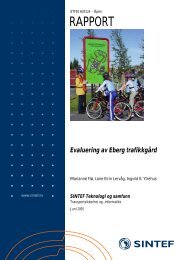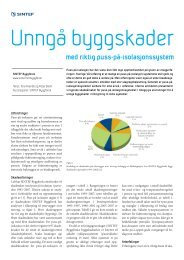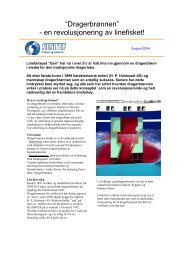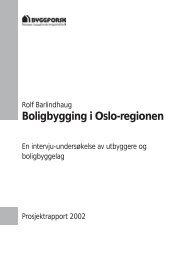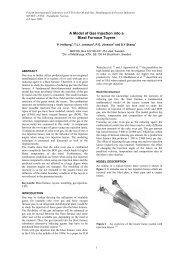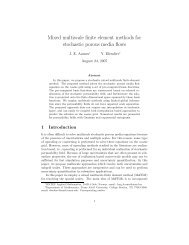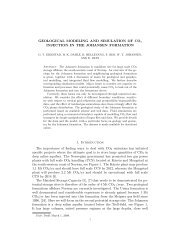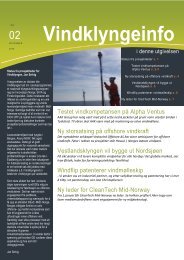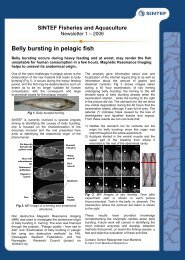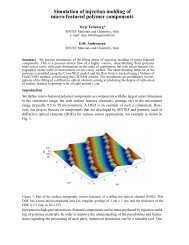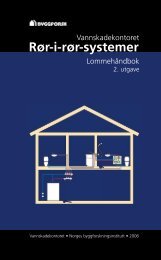Aircraft Noise Measurements at Gardermoen Airport - Sintef
Aircraft Noise Measurements at Gardermoen Airport - Sintef
Aircraft Noise Measurements at Gardermoen Airport - Sintef
Create successful ePaper yourself
Turn your PDF publications into a flip-book with our unique Google optimized e-Paper software.
WHAT FAO IS DOING:5STRENGTHEN POLITICAL WILLwe support governments anddevelopment partners to design the rightpolicies, programmes and legal frameworksth<strong>at</strong> promote food security and nutrition.we advoc<strong>at</strong>e for the implement<strong>at</strong>ionof these policies and programmes,encouraging sufficient financial resources tobe made available, the right organiz<strong>at</strong>ionalstructures to be in place, and importantly,ensuring adequ<strong>at</strong>e human capacities.ENHANCE GOVERNANCEAND COORDINATIONwe enhance the capacity of allstakeholders to put in place governanceand coordin<strong>at</strong>ion mechanisms and broadpartnerships for more focused andcoordin<strong>at</strong>ed action towards the eradic<strong>at</strong>ionof hunger and malnutrition.IMPROVE IMPLEMENTATION,MONITORING AND EVALUATIONwe assist countries in ensuring th<strong>at</strong>the formul<strong>at</strong>ion of policies, investment andaction plans is based on evidence; helpingcountries in gener<strong>at</strong>ing credible d<strong>at</strong>a andst<strong>at</strong>istics, and strengthening analyticalcapacities.we work with partners to monitorprogress, assess impact and learn lessonsfrom their efforts in food security andnutrition.we encourage partners to makesure th<strong>at</strong> action <strong>at</strong> all levels (global,regional and country) produces country-leveltangible and measurable results towards theeradic<strong>at</strong>ion of hunger, food insecurity andmalnutrition.©FAO/Marco Longari
62 Measurement Program2.1 Measurement site and measurement positionsThe site for the noise measurements was loc<strong>at</strong>ed to the north and east of the western runwaysystem, as shown in Appendix 1. The measurement positions are numbered 1 - 5. Position 1 issitu<strong>at</strong>ed inside the airport area, directly below the flight p<strong>at</strong>h and 400 m from the runway end.Position 2 is also in line with the runway, just outside the airport area <strong>at</strong> a distance of 1150 m fromthe runway end. Positions 2 - 5 are situ<strong>at</strong>ed on a straight line slightly tilted to the perpendicular tothe runway extension. The distances from position 2 are 400 m, 800 m and 1250 m for positions 3,4 and 5 respectively.The terrain along the line of measurement positions is rel<strong>at</strong>ively fl<strong>at</strong>, although smooth terrainundul<strong>at</strong>ion occurs causing terrain height vari<strong>at</strong>ions of a few meters. The ground type in the area ismainly sandy soil, with varying extent of grass coverage. Position 2 is situ<strong>at</strong>ed <strong>at</strong> the border of aspruce forest area. Position 5 is placed in an area sparsely covered by tall spruce or deciduous trees.Else, the area of the measurement positions is open land.An agreement with the Airline Company SAS was vital to the program to <strong>at</strong>tain flight-recorder d<strong>at</strong>afrom selected flights. The SAS oper<strong>at</strong>ions <strong>at</strong> OSL mainly consist of narrow-body aircraft of the MD80 family, “Next Gener<strong>at</strong>ion” B737s and a few MD90s.2.2 Acoustical Instrument<strong>at</strong>ionThe measurement positions 2 - 5 all had microphones <strong>at</strong> two heights. The lower microphone wasput <strong>at</strong> 1.5 m above ground. The higher microphone height varied between 6.5 - 10.5 m aboveground. At measurement position 1 only one microphone was used. This microphone was <strong>at</strong>tachedto the runway approach light bar arrangement, approxim<strong>at</strong>ely 6.5 m above ground.The acoustic measurement equipment consisted of condenser microphones (1/2" with standard 9cm diameter windscreen) connected to Nor-121 Environmental Analysers manufactured byNorsonic AS. Instrument<strong>at</strong>ion is described in detail in Part 2 of the report. A schem<strong>at</strong>ic layout isshown in Appendix 1 of this report.The instruments were pre-set to measure LEQ and LMAX(FAST) in 0.25-second intervals in 1/3-octave frequency bands 25 - 10,000 Hz and both A-weighted and C-weighted. The d<strong>at</strong>a were storedelectronically <strong>at</strong> each position and <strong>at</strong> the end of every session the d<strong>at</strong>a were transferred to acomputer and recorded to CD-ROM.2.3 Measurement synchronis<strong>at</strong>ionFor synchronis<strong>at</strong>ion purposes, the measurement instruments were connected to a PC with speciallydesigned software for gener<strong>at</strong>ing trigger signals and reading/storing of trigger signal time from anexternal GPS clock. Three GPS clocks were used; one for position no. 1, one for position number 2- 5, and one for synchronis<strong>at</strong>ion of aircraft movements on the runway.2.4 <strong>Aircraft</strong> TrackingThe task was to determine the position of an aircraft <strong>at</strong> a certain moment of time during the noisemeasurement. Additionally, other flight parameters such as velocity and thrust level had to besynchronised with the noise measurements. D<strong>at</strong>a from the airport radar tracking system wasavailable, as well as flight-recorder d<strong>at</strong>a from selected flights. Below is an outline of the proceduresth<strong>at</strong> were investig<strong>at</strong>ed.
8other flight parameters were taken from the flight recorder after time synchronising as described in(2), and correcting as described in (7) and (8).For the 737s and MD90s, the position vs. time were taken from the GPS position d<strong>at</strong>a in the flightrecorder, after time synchronising and position adjustment as described in (2), (4) and (6). All otherflight parameters were taken from the flight recorder d<strong>at</strong>a after time synchronising as described in(2), and correcting as described in (7) and (8).2.5 Meteorological and Ground Type D<strong>at</strong>aA 10 meters high mast with meteorological equipment was erected <strong>at</strong> position no. 4 as shown inAppendix 2. The following parameters were recorded every minute:- Temper<strong>at</strong>ures (°C) <strong>at</strong> two heights, 0.5 m and 9.25 m above ground,- Wind velocity and wind gust (m/s), wind direction, all <strong>at</strong> 9.25 m height,- Rel<strong>at</strong>ive humidity (%) <strong>at</strong> 9.25 m height,- Precipit<strong>at</strong>ion (rainfall) (mm)- Net radi<strong>at</strong>ion (W/m 2 )The net radi<strong>at</strong>ion was measured in an <strong>at</strong>tempt to estim<strong>at</strong>e the rel<strong>at</strong>ive cloud cover in the sky.All d<strong>at</strong>a are average values, except for wind gusts th<strong>at</strong> represent maximum values. Graphicalpresent<strong>at</strong>ions are presented in Appendix 2.The acoustic impedance of the ground surface was measured <strong>at</strong> the measurement positions exceptfor position no. 1. A typical measurement layout is shown in Appendix 3.2.6 Measurement ProceduresThe noise measurements were carried out during June 20 – 27, 2001. The measurements werearranged in two separ<strong>at</strong>e sessions each day. The sessions lasted for 2.5 – 4 hours. After acousticcalibr<strong>at</strong>ion the equipment were brought in position and checked for proper oper<strong>at</strong>ion. Theequipment were all b<strong>at</strong>tery oper<strong>at</strong>ed. The measurements were started independently <strong>at</strong> site I(position 1) and site II (positions 2 – 5) by the site PC giving a trigger signal, and simultaneouslyrecording the GPS time. The measurement of sound levels according to section 2.2 then proceededcontinuously through the session. Positions 2 – 5 were manned in order to register events ofbackground noise th<strong>at</strong> might affect the aircraft noise.Personnel situ<strong>at</strong>ed in the airport control tower registered the aircraft movements as described insection 2.4. The registr<strong>at</strong>ions included the GPS time for the special movements along with the flightidentific<strong>at</strong>ion and the arrival/departure time. All the registr<strong>at</strong>ions were saved on d<strong>at</strong>a files.At the end of the sessions the measurements were stopped manually by the <strong>at</strong>tending personnel.After the last session each day the equipment were collected for acoustic calibr<strong>at</strong>ion, transferring ofd<strong>at</strong>a files to a main PC, making backup CDs, etc.
93 D<strong>at</strong>a Reduction and Processing, Overview3.1 Time-Space-Position AnalysisThe position of the aircraft as function of time was extracted from the airport radar tracking system,the aircraft flight recorder, and manual GPS clock oper<strong>at</strong>ions, as described in section 2.4. For allaircraft, the position d<strong>at</strong>a and the other flight parameters were interpol<strong>at</strong>ed to have a regular, 0.5-second step length. There were a total of 155 valid flights, 70 with position taken from the aircraftGPS, and 85 with position taken from the airport radar tracking system.The aircraft position d<strong>at</strong>a was given as east/north co-ordin<strong>at</strong>es, and height above runway. Using theco-ordin<strong>at</strong>es of the measurement positions and the height of the microphones above ground, thetriplet (east, north, height) was replaced with the triplet (l<strong>at</strong>eral distance, elev<strong>at</strong>ion angle, azimuthangle rel<strong>at</strong>ive to north). In this way the position of the aircraft was expressed in units needed for thefollowing d<strong>at</strong>a processing.3.2 Net thrust d<strong>at</strong>aFlight recorder d<strong>at</strong>a provide engine thrust settings th<strong>at</strong> has to be transformed into net thrust.Equ<strong>at</strong>ions for this purpose are found in the SAE AIR 1845 [6]. When the aircraft engines are beingoper<strong>at</strong>ed <strong>at</strong> thrusts other than r<strong>at</strong>ed thrust, the thrust developed is a function of the thrust-settingparameter. When engine pressure r<strong>at</strong>io (EPR) is available the corrected net thrust per engine iscalcul<strong>at</strong>ed by:( Fn amC A Bam+12/ δ ) = E + FV + G h + G h + HT K ( EPR)(3.1)F n is the net thrust per engine,δ am is the r<strong>at</strong>io of the ambient air pressure <strong>at</strong> the aeroplane to the standard air pressure <strong>at</strong> meansea level,V c is the calibr<strong>at</strong>ed airspeed (kts),h is the pressure altitude above sea level,T am is the ambient air temper<strong>at</strong>ure,E, F, G A , G B , K 1 and H are constants or coefficients, which are taken from the INM 6.0cd<strong>at</strong>abase for the relevant oper<strong>at</strong>ing conditions,EPR, V c and h are available from the flight-recorder d<strong>at</strong>a.When the thrust is defined by N 1 , the corrected net thrust is calcul<strong>at</strong>ed by:22( Fn/ δam) = E + FVC+ GAh+ GBh+ HTam+ K2( N1/ θT) + K3( N1/ θT) (3.2)N 1 is the engine's low pressure rotor speed,θ T is the r<strong>at</strong>io of absolute total air pressure <strong>at</strong> the engine inlet to the absolute standard airtemper<strong>at</strong>ure <strong>at</strong> mean sea level,K 2 and K 3 are coefficients, which are taken from the INM 6.0c d<strong>at</strong>abase for the relevantoper<strong>at</strong>ing conditions.3.3 <strong>Noise</strong> event extraction – exclusion of background noise influenceThe raw noise level measurement results were filtered to determine a background noise level.Background noise level was defined separ<strong>at</strong>ely for each 1/3-octave band as the level th<strong>at</strong> wasexceeded 90% of the time (L90). The background noise level was determined for a 30-minute widetime window, which was moving in 5-minute steps.
10The personnel <strong>at</strong> each measurement site registered random noise disturbances like vehicle noise,bird singing, voices, etc. Not all of these possible disturbances had significant sound levelscompared to the aircraft noise. Therefore, the time intervals of these disturbances had to bemanually defined afterwards, based on the shape of the time history. Both the A-weighted and the1/3-octave band d<strong>at</strong>a were used to find and define the time intervals of the significant disturbances.To loc<strong>at</strong>e noise d<strong>at</strong>a corresponding to a specific flight, and to elimin<strong>at</strong>e the effects of backgroundnoise and noise from preceding/succeeding flights, the following criteria were applied in the orderlisted (only landing criteria are listed; takeoff criteria were similar):1. <strong>Noise</strong> d<strong>at</strong>a time window must be inside time window of aircraft position d<strong>at</strong>a (the delay of thesound propag<strong>at</strong>ion is accounted for).2. <strong>Noise</strong> d<strong>at</strong>a must not include time intervals with disturbance.3. A peak must be found within 60 seconds before touchdown, and minima must be foundbetween touchdown and 90 seconds before touchdown.4. <strong>Noise</strong> level must be higher than 10 dB above the levels <strong>at</strong> the minima.5. <strong>Noise</strong> level must also be higher than 10 dB above the background noise level.6. The remaining noise d<strong>at</strong>a must span <strong>at</strong> least 10 dB down <strong>at</strong> either side of peak.The table below shows the number of valid flights after the criteria above were applied to the A-weighted noise d<strong>at</strong>a. For the 1/3-octave band d<strong>at</strong>a, the number of valid noise events were dependenton frequency.Table 3.1Number of valid noise events after applying filtering criteria<strong>Aircraft</strong> type Pos. 1 Pos. 2 Pos. 3 Pos. 4 Pos. 5 TotalB736 31 20 24 27 30 132B737 35 23 31 31 27 147B738 2 1 2 1 1 7MD81 24 18 17 19 19 97MD82 48 35 36 38 40 197MD83 1 1 1 1 1 5MD87 11 8 9 7 7 42MD90 3 3 3 3 2 14Total 155 109 123 127 127 641The result of the extraction process was d<strong>at</strong>a files containing one line per aircraft position andmeasurement position, <strong>at</strong> a time resolution of 0.5 second. Each line contained all relevant flightparameters and the corresponding measured sound level, i.e. the 0.5-second LEQ was the energyaverage of two consecutive 0.25-second LEQ.3.4 SEL calcul<strong>at</strong>ionFor each flight, the closest point of approach (CPA) was assumed to equal the position where thel<strong>at</strong>eral distance to the measurement position was smallest. At this point, the l<strong>at</strong>eral distance,elev<strong>at</strong>ion angle and slant distance was extracted, together with all the other flight parameters. Fromthe noise d<strong>at</strong>a the sound exposure level (SEL) was determined according to:Leq /10( ∑0.5⋅10)SEL = 10log(3.3)
11The sum is taken over all 0.5-second time steps for the current noise event, which fulfil the criterialisted in section 3.3. In addition the maximum level (MAX) was found, based on 1-secondequivalent sound pressure levels derived from the 0.5-second equivalent sound pressure levels.3.5 <strong>Aircraft</strong> noise spectraFor all aircraft types, average noise spectra were found for takeoff and landing. The spectra werebased on SEL values for each 1/3-octave band. Only d<strong>at</strong>a from measurement positions 1 and 2 wereused. The sound <strong>at</strong>tenu<strong>at</strong>ion in air was accounted for by using the ISO 9613-1 standard [4]. Atemper<strong>at</strong>ure of 20 degrees Celsius and a rel<strong>at</strong>ive humidity of 60% were used, in accordance withmeasured average we<strong>at</strong>her conditions. The distance used for the sound <strong>at</strong>tenu<strong>at</strong>ion was the height ofthe aircraft above the microphone <strong>at</strong> CPA.3.6 Meteorological and Ground Type d<strong>at</strong>aThe meteorological d<strong>at</strong>a are already suitably processed by recording values for subsequent 1 minuteintervals. This is assumed to be sufficient to link meteorological parameters to single flights.As can be seen from the accumul<strong>at</strong>ed we<strong>at</strong>her description in Appendix 2, wind speeds were mostlylow (i.e. wind speeds well below 5 m/s). The wind direction was mostly due North or South, whichmeans minor components of down- or up-wind <strong>at</strong> the measurement positions. The temper<strong>at</strong>uregradient revealed prevailing neg<strong>at</strong>ive values, corresponding to summer conditions with varyingsunlight brightness.The acoustic impedance of the ground surface was assumed to follow the Delaney/Bazley model.The important parameter is the flow resistivity (Pa s/m 2 ) which was determined from acousticmeasurements according to Nordtest standard [3], for a number of test areas <strong>at</strong> the measurementpositions. The main result is the average flow resistivity relevant to positions 2 - 5, as given inTable 3.2.Table 3.2 Measured Flow Resistivity (kPa s/m 2 )Pos. no. 2 Pos. no. 3 Pos. no. 4 Pos. no. 5400 250 250 - 400 100
124 D<strong>at</strong>a AnalysisThe d<strong>at</strong>a analysed in this chapter are all based on the 155 valid flights shown in Table 3.1.4.1 <strong>Noise</strong> source directivityThis chapter presents noise source directivity 2 of the measured aircraft types separ<strong>at</strong>ed for each 1/3-octave frequency band from 25 to 10,000 Hz. The directivity is calcul<strong>at</strong>ed from the measured d<strong>at</strong>a,using a propag<strong>at</strong>ion model th<strong>at</strong> elimin<strong>at</strong>es the influence of distance, ground surface and we<strong>at</strong>her,thus giving the actual sound emission from the aircraft. Part 2 of the report includes a memo withall results. This chapter only highlights a few of the major findings.4.1.1 Analysis toolsThe sound pressure level of every measurement sample (2 per second) is propag<strong>at</strong>ed back to thesource, using the model Nord 2000 [12]. This is a modern ray-tracing model, which accounts forthe influence of topography, ground impedance, wind- and temper<strong>at</strong>ure gradients, and turbulenceeffects in the <strong>at</strong>mosphere. The calcul<strong>at</strong>ions are done in a special developed MATLAB® program. Todescribe the 3D directivity as precise as possible, the program accounts for all aircraft angles(heading, pitch and roll), as well as the full source-to-receiver geometry.A separ<strong>at</strong>e computer program has been developed to visualise the source directivity. The result isdisplayed as a colour map of the hemisphere below the aircraft, projected to a plane. Thehemisphere above the aircraft is disregarded in these analyses. The projection is a hybrid polarprojection with side angle in the wing-plane (Theta) along the projection circle, and azimuth angle(Phi) displayed as radius. Theta is set to 0 in front, 90 degrees to the right, 180 degrees behind etc.Phi is 0 straight above the aircraft, 90 degrees in the wing-plane, and 180 degrees straight below(see Figure 4.1). This projection is chosen because it preserves the real area of any shape projectedfrom the hemisphere to the plane, which means th<strong>at</strong> grouping, smoothing, and other st<strong>at</strong>isticalanalyses can be based on the x, y co-ordin<strong>at</strong>es of the projection plane. The projection however, doesnot preserve the shape of any object.To help visualise any axis-symmetry in the directivity, l<strong>at</strong>eral lines are added to the diagram (seered lines in Figure 4.1). These connect points in the projection with constant angle to the flightheadingvector. Any axis-symmetry (i.e. cylindrical symmetry) in the d<strong>at</strong>a set will display ascoloured areas parallel to these lines.In the source directivity program all source d<strong>at</strong>a for one aircraft type can be displayed. Differentfilters can be added to the d<strong>at</strong>a to investig<strong>at</strong>e how the directivity changes due to oper<strong>at</strong>ion (arrivaland departure), thrust interval, frequency, measurement position and microphone height. In additiond<strong>at</strong>a can be excluded based on user defined parameters for background noise, source – receiverdistance, aircraft elev<strong>at</strong>ion angle, and quality indic<strong>at</strong>ors in the propag<strong>at</strong>ion model.2 The term “directivity” used herein is the distribution of backwards propag<strong>at</strong>ed sound pressure levels over thehemisphere below the aircraft. This should not be mixed with the normalised directivity th<strong>at</strong> usually characterisessingle sound sources.
13Figure 4.1 Directivity projection. Theta angles in blue (outside circle). Phi angles in grey(inside circle). L<strong>at</strong>eral lines (axis-symmetric) display equal angle to flight vector.Finally the program is able to calcul<strong>at</strong>e st<strong>at</strong>istics for a resulting averaged source directivity, andproduce report files containing source spectra, directivity plots and tables. Directivity parametersare averaged according to a grid. We assume symmetry between right and left side of the aircraft.Thus all d<strong>at</strong>a are transferred to the right-hand side of the aircraft before st<strong>at</strong>istical analyses. Tocover all angles, the grid-cells with less than 10 samples are autom<strong>at</strong>ic set equal to the closest gridcellwith more than 10 samples. The resulting averaged source directivities with correspondingst<strong>at</strong>istics are tabul<strong>at</strong>ed in ASCII text files. They are not included in this report due to spacelimit<strong>at</strong>ions.4.1.2 Backward propag<strong>at</strong>ion parametersThe backward propag<strong>at</strong>ion from receiver to source is based on:• Nord 2000 algorithms.• Actual geometry including flight position and orient<strong>at</strong>ion sampled every 0.5-second.• Actual ground impedance measured close to the receiver.• Air absorption based on actual measured temper<strong>at</strong>ure and humidity, smoothed over 30minutes.• Actual wind speed and direction smoothed over 7 minutes.
14• Temper<strong>at</strong>ure gradient is set to –1 degrees per 100 meter, in accordance with measuredmeteorology and expert judgement [13] of the total we<strong>at</strong>her situ<strong>at</strong>ion.• No topography corrections (horizontal ground assumed).• After backward propag<strong>at</strong>ion, the d<strong>at</strong>a is normalised to a fixed thrust setting of 10,000Lbs. This is done by subtracting 1.1 dB per 1000 Lbs. thrust exceeding 10,000 Lbs.4.1.3 D<strong>at</strong>a filteringA series of test calcul<strong>at</strong>ions of source directivity were done to verify the quality, and find optimumsettings for filtering parameters. The goal was to exclude suspicious d<strong>at</strong>a, and gain highest possiblest<strong>at</strong>istic strength in the results. Preliminary results indic<strong>at</strong>ed th<strong>at</strong> the directivity does not changemuch with varying thrust, so the figures display the directivity as an average for all measured thrustsettings, after separ<strong>at</strong>ion between arrival and departure.The optimised filter settings where:• No specific adjustment for background noise other than wh<strong>at</strong> was done with the rawmeasurement d<strong>at</strong>a (se Section 3.3).• All d<strong>at</strong>a propag<strong>at</strong>ed more than 2 km where excluded.• On departures, all d<strong>at</strong>a propag<strong>at</strong>ed <strong>at</strong> an elev<strong>at</strong>ion angle less than 15 degrees wereexcluded. 3 On arrivals no d<strong>at</strong>a where excluded due to elev<strong>at</strong>ion angle.• All d<strong>at</strong>a with air and ground <strong>at</strong>tenu<strong>at</strong>ion more than 30 dB were excluded.4.1.4 Directivity resultsIn the technical memo in part 2 of the report the directivity plots are shown for each aircraft type.The d<strong>at</strong>a is organised as one spectrum table and 27 directivity plots, one for every 1/3-octave band.The table covers all measured directions from the aircraft, and has the following columns:• Freq.: 1/3-octave centre frequency from 25 to 10,000 Hz.• Num.: Number of 0.5-second measurement samples.• Avg.: Arithmetic average sound level 1 meter from a point representing the aircraft• Std: Standard devi<strong>at</strong>ion of the 0.5-second sound levels.• 95%Avg: The +/- devi<strong>at</strong>ion for the average sound level, within 95% confidence interval.• P1, …P6: Average level for each engine power setting, grouped according to the NPDtable. (No d<strong>at</strong>a is denoted –1).The directivity plots show all 0.5-second samples as noise levels 1 meter from a point representingthe aircraft. They are plotted in the projection of the hemisphere below the aircraft, describedabove, as one small circle per sample. The colour of the circle indic<strong>at</strong>es the devi<strong>at</strong>ion from theaverage of all samples, according to a colour scale ranging +/- 15 dB. Black circles indic<strong>at</strong>e th<strong>at</strong> thesample is outside the colour scale.At the top of both tables and directivity plots, the aircraft type is indic<strong>at</strong>ed, along with the one letterindic<strong>at</strong>or “A” for arrival and “D” for departure. In the plots, the 1/3-octave centre frequency, andaverage sound level is indic<strong>at</strong>ed.Table 4.1 and 4.2 show examples of directivity d<strong>at</strong>a for the aircraft B737-600 and MD82 ondeparture.3 This filter only removes d<strong>at</strong>a in front of the aircraft and does not influence d<strong>at</strong>a to the side or behind.
15Table 4.1B737 600 mean spectrum on departureSPECTRUMSource EmissionB736DFreq. Num. Avg. Std 95%Avg P1 P2 P3 P4 P5 P625 7426 120.2 6.7 0.2 -1.0 -1.0 119.4 120.3 -1.0 -1.031.5 8568 121.9 6.0 0.1 -1.0 -1.0 121.1 121.9 -1.0 -1.040 8738 122.5 5.6 0.1 -1.0 -1.0 121.9 122.6 -1.0 -1.050 9146 123.1 5.2 0.1 -1.0 -1.0 122.1 123.2 -1.0 -1.063 9345 124.2 5.0 0.1 -1.0 -1.0 122.5 124.4 -1.0 -1.080 9799 125.4 4.7 0.1 -1.0 -1.0 122.9 125.6 -1.0 -1.0100 9982 125.3 4.3 0.1 -1.0 -1.0 122.5 125.6 -1.0 -1.0125 10195 124.6 4.3 0.1 -1.0 -1.0 122.0 124.8 -1.0 -1.0160 10203 123.6 4.6 0.1 -1.0 -1.0 120.7 123.9 -1.0 -1.0200 10298 123.0 5.0 0.1 -1.0 -1.0 119.5 123.3 -1.0 -1.0250 10331 122.5 4.9 0.1 -1.0 -1.0 120.0 122.7 -1.0 -1.0315 10365 121.4 5.3 0.1 -1.0 -1.0 118.0 121.7 -1.0 -1.0400 10344 120.5 5.6 0.1 -1.0 -1.0 117.1 120.8 -1.0 -1.0500 10330 119.9 6.0 0.1 -1.0 -1.0 116.0 120.3 -1.0 -1.0630 10286 119.0 5.7 0.1 -1.0 -1.0 115.1 119.3 -1.0 -1.0800 10254 118.1 5.3 0.1 -1.0 -1.0 113.9 118.5 -1.0 -1.01000 10210 117.5 5.4 0.1 -1.0 -1.0 113.2 117.9 -1.0 -1.01250 10219 117.2 5.5 0.1 -1.0 -1.0 112.8 117.5 -1.0 -1.01600 10188 117.3 5.6 0.1 -1.0 -1.0 112.8 117.7 -1.0 -1.02000 9856 118.2 6.1 0.1 -1.0 -1.0 114.1 118.6 -1.0 -1.02500 9198 119.0 5.2 0.1 -1.0 -1.0 116.7 119.2 -1.0 -1.03150 7390 120.7 5.2 0.1 -1.0 -1.0 120.1 120.8 -1.0 -1.04000 4334 121.2 5.4 0.2 -1.0 -1.0 121.2 121.2 -1.0 -1.05000 1772 121.1 5.2 0.2 -1.0 -1.0 120.8 121.1 -1.0 -1.06300 463 120.7 5.8 0.5 -1.0 -1.0 121.6 120.6 -1.0 -1.08000 81 119.5 7.2 1.6 -1.0 -1.0 122.0 119.1 -1.0 -1.010000 7 111.6 7.4 5.5 -1.0 -1.0 -1.0 111.6 -1.0 -1.0
16Figure 4.2<strong>Noise</strong> source directivity p<strong>at</strong>tern B737-600 Departure for some 1/3 octave bands
Figure 4.3 <strong>Noise</strong> source directivity p<strong>at</strong>tern B737-600 Arrival for some 1/3 octave bands17
18Table 4.2MD 82 mean spectrum on departureSPECTRUMSource EmissionMD82DFreq Num Avg Std 95%Avg P1 P2 P3 P4 P5 P625 13546 124.2 8.3 0.1 -1.0 -1.0 -1.0 -1.0 125.2 -1.031.5 14365 126.1 8.1 0.1 -1.0 -1.0 -1.0 -1.0 127.1 -1.040 15589 127.0 8.0 0.1 -1.0 -1.0 -1.0 -1.0 128.0 -1.050 15535 128.3 8.2 0.1 -1.0 -1.0 -1.0 -1.0 129.3 -1.063 15698 130.0 8.5 0.1 -1.0 -1.0 -1.0 -1.0 131.0 -1.080 16139 131.4 8.1 0.1 -1.0 -1.0 -1.0 -1.0 132.4 -1.0100 17310 131.5 7.4 0.1 -1.0 -1.0 -1.0 -1.0 132.3 -1.0125 18411 131.0 6.3 0.1 -1.0 -1.0 -1.0 -1.0 131.6 -1.0160 18694 130.6 5.8 0.1 -1.0 -1.0 -1.0 -1.0 131.0 -1.0200 18727 130.4 5.9 0.1 -1.0 -1.0 -1.0 -1.0 130.8 -1.0250 18716 130.4 5.6 0.1 -1.0 -1.0 -1.0 -1.0 130.7 -1.0315 18689 130.2 5.7 0.1 -1.0 -1.0 -1.0 -1.0 130.3 -1.0400 18745 129.8 5.8 0.1 -1.0 -1.0 -1.0 -1.0 129.8 -1.0500 18690 129.3 5.6 0.1 -1.0 -1.0 -1.0 -1.0 129.2 -1.0630 18749 129.1 5.5 0.1 -1.0 -1.0 -1.0 -1.0 129.0 -1.0800 18610 128.8 5.4 0.1 -1.0 -1.0 -1.0 -1.0 128.7 -1.01000 18695 128.3 5.5 0.1 -1.0 -1.0 -1.0 -1.0 128.3 -1.01250 18687 127.6 5.6 0.1 -1.0 -1.0 -1.0 -1.0 127.6 -1.01600 18675 126.9 5.7 0.1 -1.0 -1.0 -1.0 -1.0 126.9 -1.02000 18504 126.6 5.7 0.1 -1.0 -1.0 -1.0 -1.0 126.6 -1.02500 17610 126.8 5.6 0.1 -1.0 -1.0 -1.0 -1.0 126.9 -1.03150 13494 126.5 5.6 0.1 -1.0 -1.0 -1.0 -1.0 127.0 -1.04000 7188 126.0 5.7 0.1 -1.0 -1.0 -1.0 -1.0 126.7 -1.05000 2948 124.4 6.5 0.2 -1.0 -1.0 -1.0 -1.0 124.7 -1.06300 803 121.0 7.6 0.5 -1.0 -1.0 -1.0 -1.0 121.5 -1.08000 150 117.1 8.5 1.4 -1.0 -1.0 -1.0 -1.0 117.1 -1.010000 19 110.9 10.4 4.7 -1.0 -1.0 -1.0 -1.0 117.2 -1.0
19Figure 4.4<strong>Noise</strong> source directivity p<strong>at</strong>tern MD82 Departure for some 1/3 octave bands
20Figure 4.5<strong>Noise</strong> source directivity p<strong>at</strong>tern MD82 Arrival for some 1/3 octave bands
214.1.5 CommentsThe directivity analyses can be summarised in the following main results:• The directivity is strongly dependent on frequency.• The directivity is fundamentally different between the aft-fuselage mounted-engineaircraft (MD8x, MD90) and wing-mounted-engine aircraft (B73x). This is especially thecase below 1000 Hz, which is the domin<strong>at</strong>ing frequency range in noise zoningsitu<strong>at</strong>ions. Aft-fuselage-mounted-engine aircraft has a very distinct directivity lobebehind and below the aircraft <strong>at</strong> mid and low frequencies, while wing-mounted-engineaircraft are more omni directional.• There is no fundamental difference in directivity between MD8x and MD90, eventhough the engine type is different.• There is a fundamental difference between the directivity of B73x and MD90, eventhough the engine type is similar. Connected to the above two points, this indic<strong>at</strong>es th<strong>at</strong>a major difference in directivity depends more on engine placement, than engine type.• The sound radi<strong>at</strong>ion downwards is generally stronger than to the side. This is clearlymost evident behind aft-fuselage- mounted-engine aircraft, <strong>at</strong> mid and lowerfrequencies.• The directivity does not change significantly within the thrust intervals covered by themeasurements.4.2 L<strong>at</strong>eral Attenu<strong>at</strong>ionTwo methods have been used to determine l<strong>at</strong>eral <strong>at</strong>tenu<strong>at</strong>ion:• Through measurements where the A-weighted d<strong>at</strong>a were used to estim<strong>at</strong>e the l<strong>at</strong>eral <strong>at</strong>tenu<strong>at</strong>ionby comparison of noise levels measured directly below the flight and <strong>at</strong> positions to the side.• Through simul<strong>at</strong>ions based on the source directivity spectra found in 4.14.2.1 L<strong>at</strong>eral <strong>at</strong>tenu<strong>at</strong>ion as measuredIt was assumed th<strong>at</strong> the measurement positions 2 – 5 were situ<strong>at</strong>ed on a line orthogonal to the flightp<strong>at</strong>h. The l<strong>at</strong>eral <strong>at</strong>tenu<strong>at</strong>ion (LA) was calcul<strong>at</strong>ed according to equ<strong>at</strong>ion (4.1):LA⎛ d ⎞k k2 k ⎜ ⎟ kK (4.1)⎝ h2⎠k( l , θ ) = SEL − SEL −10log⎜⎟ − Φ k = 3 5Here, k is the measurement position, (l k ,θ k ,d k ) is the l<strong>at</strong>eral distance, elev<strong>at</strong>ion angle and slantdistance from the measurement position to the aircraft respectively, and h 2 is the height of theaircraft above the microphone <strong>at</strong> position 2. Φ k is the A-weighted air absorption from the aircraft toposition k, which was calcul<strong>at</strong>ed according to equ<strong>at</strong>ion (4.2) :Φ[ S ] − A[ S − α( T,RH,)]= A (4.2)kd kHere A[] represents A-weighting, S is the noise source spectrum of the aircraft, T is thetemper<strong>at</strong>ure, RH is the rel<strong>at</strong>ive humidity, and α( ) is the frequency dependent air absorption for thegiven temper<strong>at</strong>ure, humidity and distance. For each flight, the temper<strong>at</strong>ure and rel<strong>at</strong>ive humidityvalues <strong>at</strong> the time of closest point of approach were used.
224.2.1.1 Comparison of measured l<strong>at</strong>eral <strong>at</strong>tenu<strong>at</strong>ion and SAE 1751The estim<strong>at</strong>ed l<strong>at</strong>eral <strong>at</strong>tenu<strong>at</strong>ion was developed per aircraft type and split on landing (LA) andtakeoff (TO) oper<strong>at</strong>ions.In Figure 4.6 the estim<strong>at</strong>ed l<strong>at</strong>eral <strong>at</strong>tenu<strong>at</strong>ion is compared with the standard l<strong>at</strong>eral <strong>at</strong>tenu<strong>at</strong>iongiven in SAE AIR 1751 [5]. The straight line in the figure indic<strong>at</strong>es conformity of values.Figure 4.6L<strong>at</strong>eral <strong>at</strong>tenu<strong>at</strong>ion, measured versus SAE prediction.
23In Figure 4.7 the estim<strong>at</strong>ed l<strong>at</strong>eral <strong>at</strong>tenu<strong>at</strong>ion is presented as a function of elev<strong>at</strong>ion angle. Alsoshown is the l<strong>at</strong>eral <strong>at</strong>tenu<strong>at</strong>ion according to SAE AIR 1751, corresponding to values <strong>at</strong> 300-mdistance, and to maximum <strong>at</strong>tenu<strong>at</strong>ion (distance 914 m or more) which covers the actual span inl<strong>at</strong>eral distance in this study.Figure 4.7Measured l<strong>at</strong>eral <strong>at</strong>tenu<strong>at</strong>ion versus elev<strong>at</strong>ion angle.4.2.1.2 Comments on measured l<strong>at</strong>eral <strong>at</strong>tenu<strong>at</strong>ionThe results indic<strong>at</strong>ed above may be influenced by thrust cutback during take off. Cutback isassumed to occur <strong>at</strong> an aircraft height of approxim<strong>at</strong>ely 450-500 m above runway elev<strong>at</strong>ion. Thismeans th<strong>at</strong> a small part of the takeoffs (TO) may be affected. However, the engine power cutbackrepresents a certain noise level reduction in both SEL 2 and SEL k in equ<strong>at</strong>ion (4.1). The net effect inFigures 4.6 and 4.7 is therefore expected to be r<strong>at</strong>her small.The measured l<strong>at</strong>eral <strong>at</strong>tenu<strong>at</strong>ion shows clearly th<strong>at</strong> SAE AIR1751 overestim<strong>at</strong>es the effect forthese aircraft. Since l<strong>at</strong>eral <strong>at</strong>tenu<strong>at</strong>ion in the recommend<strong>at</strong>ion combines effects from directivity,install<strong>at</strong>ion of engines and ground <strong>at</strong>tenu<strong>at</strong>ion, it is not clear wh<strong>at</strong> contributes most to thedifferences measured. There is a tendency th<strong>at</strong> B737 models have less l<strong>at</strong>eral <strong>at</strong>tenu<strong>at</strong>ion thanMD80 models. This may be due to any of the effects, since both noise source spectra, directivityand install<strong>at</strong>ion are different. Further investig<strong>at</strong>ions have therefore been undertaken to distinguishbetween the possible causes.4.2.2 Simul<strong>at</strong>ed l<strong>at</strong>eral <strong>at</strong>tenu<strong>at</strong>ionThe noise resulting from horizontal straight line flights have been simul<strong>at</strong>ed. The sound emission ofthe source is modelled by the spectra and directivities described in chapter 4.1. Flight speed is fixedto 160 knots, while flight height is variable.Sound pressure levels are calcul<strong>at</strong>ed <strong>at</strong> different receiver points 1.5 meters above the ground belowthe flight line and to the side. Nord 2000 algorithms have been used to calcul<strong>at</strong>e the noise
24propag<strong>at</strong>ion from points along the flight line to the receiver point. Distance from receiver point toclosest point of approach is kept constant <strong>at</strong> two distances.The propag<strong>at</strong>ion conditions are set to:• Horizontal ground with a flow resistivity = 250,000 Pa s/m 2 .• Temper<strong>at</strong>ure = 15° Celsius.• Rel<strong>at</strong>ive humidity = 70%.• Wind speed = 0.• Temper<strong>at</strong>ure gradient = -1°C/100m.• Wind turbulence parameter = 0.5.The turbulence parameter expresses the strength of turbulence due to wind. The value of thisparameter is adjusted by comparison between simul<strong>at</strong>ed and measured vertically separ<strong>at</strong>ed soundpressure levels.The sound pressure levels <strong>at</strong> the receiver points are accumul<strong>at</strong>ed to A-weighted SEL values for thewhole flight.The following figure shows the difference between SEL below the flight line, and SEL to the side<strong>at</strong> the same distance from the point. The results are plotted as function of elev<strong>at</strong>ion angle for MD82and B737-600. To indic<strong>at</strong>e distance dependency, the curves are given <strong>at</strong> both 300 and 1200 meters.Simul<strong>at</strong>ed propag<strong>at</strong>ionL<strong>at</strong>eral Attenu<strong>at</strong>ion incl. Ground Effect109876543210-1-20 10 20 30 40 50 60 70 80 90Elev<strong>at</strong>ion Angle (degrees)MD82 <strong>at</strong> 300mB736 <strong>at</strong> 300mMD82 <strong>at</strong> 1200mB736 <strong>at</strong> 1200mFigure 4.8Simul<strong>at</strong>ed l<strong>at</strong>eral <strong>at</strong>tenu<strong>at</strong>ion (dBA)The spectral source directivity and the ground <strong>at</strong>tenu<strong>at</strong>ion both influence the curves. The differencebetween the two aircraft is caused by the spectral source directivity. Since directivity seems to bemore dependent on engine position than engine class, it can be concluded th<strong>at</strong> the main differencebetween the two aircraft l<strong>at</strong>eral <strong>at</strong>tenu<strong>at</strong>ion is due to engine position.
254.3 <strong>Noise</strong>-Power-Distance d<strong>at</strong>aThe measured A-weighted d<strong>at</strong>a were used to estim<strong>at</strong>e the noise-power-distance d<strong>at</strong>a. Only d<strong>at</strong>afrom measurement positions 1 and 2 were used, i.e. the positions directly below the flight p<strong>at</strong>h.4.3.1 Analysis methodThe measured levels were normalised from the actual <strong>at</strong>mosphere represented by ISO air absorptioncoefficients for the ambient temper<strong>at</strong>ure and rel<strong>at</strong>ive humidity to the <strong>at</strong>mosphere represented by theair absorption coefficients tabul<strong>at</strong>ed in SAE AIR 1845 [6]. The A-weighted SEL levels for eachflight were corrected for speed by adding the correction V corr = 10log(V/160) according to SAE AIR1845, where V is the velocity (kts) of the aircraft <strong>at</strong> CPA.The A-weighted SEL- and MAX levels were compared to the corresponding noise curves from theNORTIM d<strong>at</strong>abase noise-power-distance tables. For comparison with the NORTIM curves, thethrust levels of the measured d<strong>at</strong>a were grouped in intervals corresponding to the thrust levels of theNORTIM curves. The measured level <strong>at</strong> a specific thrust value was normalised to the curve valueby linear interpol<strong>at</strong>ion between the d<strong>at</strong>abase noise levels.For the B737-600, the measured noise d<strong>at</strong>a are compared with the NPD curves for B737-500 fromthe d<strong>at</strong>abase, since the l<strong>at</strong>ter lacks d<strong>at</strong>a for this specific aircraft type. Also, <strong>at</strong> this point, no d<strong>at</strong>a forthe B737-700 were included in the NORTIM d<strong>at</strong>abase, and comparison for this aircraft type waswith the d<strong>at</strong>a for B737-400.4.3.2 ResultsA technical memo with all results is incorpor<strong>at</strong>ed in Part 2 of the report. The memo contains figureswith comparisons of measurement results and d<strong>at</strong>abase values for all the different aircraft types th<strong>at</strong>were in the study for both SEL and LAMAX values. The following figures show the results for thetwo dominant aircraft types in the study, the MD 82 and the B737-600 (B736). In the followingfigures, the thrust levels of the NORTIM curves are annot<strong>at</strong>ed along the curves.
26Figure 4.9Comparison of d<strong>at</strong>abase (NPD) and measured SEL for B737-600.Figure 4.10Comparison of d<strong>at</strong>abase (NPD) and measured LAMAX for B737-600.
27Figure 4.11 Comparison of d<strong>at</strong>abase (NPD) and measured SEL for MD 82.Figure 4.12Comparison of d<strong>at</strong>abase (NPD) and measured LAMAX for MD82.
28Note th<strong>at</strong> the NORTIM d<strong>at</strong>abase levels for MD82 has been adjusted by + 1.5 dB for both SEL andLAMAX for the two upper thrust settings as compared to the INM d<strong>at</strong>abase.4.3.3 St<strong>at</strong>istical analysisThe devi<strong>at</strong>ions (in dBA) between the NPD curves from the d<strong>at</strong>abase and the normalised d<strong>at</strong>a havebeen analysed and the st<strong>at</strong>istics on the differences are given in the following tables: for differencesin SEL values and LAMAX values respectively. The number of observ<strong>at</strong>ions, mean value, standarddevi<strong>at</strong>ion and limits for the 95% confidence interval are shown for each aircraft and oper<strong>at</strong>ion.A positive mean value suggests th<strong>at</strong> the d<strong>at</strong>abase NPD curves give too high noise value. Meandifferences are not significant if the number 0 lies between the limits of the 95% confidenceinterval.Table 4.3St<strong>at</strong>istical analysis of SEL value differencesType Oper<strong>at</strong>ion No of Obs Mean St.dev CI_low CI_highB736 LA 20 4.1 1.6 3.4 4.9B737 LA 22 3.8 1.4 3.1 4.4B738 LA 3 1.4* 2.1 -3.8 6.6MD81 LA 13 -2.6 0.7 -3.0 -2.2MD82 LA 25 -1.6 1.6 -2.3 -1.0MD87 LA 8 -2.4 1.4 -3.5 -1.2MD90 LA 2 8.9* 6.5 -49.5 67.2B736 TO 31 -0.9 1.2 -1.4 -0.5B737 TO 36 -0.8 1.8 -1.4 -0.2MD81 TO 29 -0.8 1.1 -1.3 -0.4MD82 TO 58 -1.4 1.5 -1.8 -1.0MD83 TO 2 0.1* 1.6 -14.5 14.8MD87 TO 11 -1.1 1.2 -1.9 -0.3MD90 TO 4 -2.0 1.0 -3.5 -0.5* not significantTable 4.4St<strong>at</strong>istical analysis of LAMAX value differencesType Oper<strong>at</strong>ion No of Obs Mean St.dev CI_low CI_highB736 LA 20 6.0 2.5 4.9 7.2B737 LA 22 6.3 2.6 5.1 7.4B738 LA 3 4.2* 2.7 -2.4 10.8MD81 LA 13 -1.8 1.1 -2.4 -1.1MD82 LA 25 -0.4* 2.5 -1.5 0.6MD87 LA 8 -1.6 1.8 -3.1 -0.1MD90 LA 2 12.3* 10.9 -85.9 110.5B736 TO 31 0.2* 1.6 -0.4 0.8B737 TO 36 0.4* 2.0 -0.3 1.1MD81 TO 29 -0.5* 1.9 -1.2 0.2MD82 TO 58 -1.2 2.4 -1.8 -0.6MD83 TO 2 0.7* 2.0 -17.1 18.6MD87 TO 11 -1.0* 1.6 -2.1 0.1MD90 TO 4 -3.8 1.0 -5.4 -2.2* not significant
294.3.4 CommentsIt is clear from the results th<strong>at</strong> there are st<strong>at</strong>istically significant differences between measured noised<strong>at</strong>a and the d<strong>at</strong>abase values for similar thrust setting and distance for some aircraft. The results forSEL d<strong>at</strong>a is generally more stable with higher confidence than the LAMAX d<strong>at</strong>a.The devi<strong>at</strong>ions for the B737 family is not clear since substitutions have been used from thed<strong>at</strong>abase. However, the finding of a little, but st<strong>at</strong>istically significant, higher SEL noise levels fortake-off from both –600 and –700 as compared to –500 and –400 respectively, is surprising, sincethe newer variants are supposedly quieter.Norwegian authorities decided th<strong>at</strong> 1.5 dB should be added for MD80 family aircraft <strong>at</strong> take-offthrust values based on the Yuma tests in the early 1990’s [14]. Still the d<strong>at</strong>abase underestim<strong>at</strong>es theSEL values with up to 1.4 dB.4.4 Comparison of actual flight profiles with d<strong>at</strong>abaseA flight profile is defined as altitude, velocity and engine thrust settings as a function of distancefrom a reference point along the flight track. For a take-off profile, the reference point is the brakerelease point. For approach profiles, the reference point is the runway threshold <strong>at</strong> the touch downend of the runway.Flight recorder d<strong>at</strong>a give the possibility of constructing actual flight profiles. All 155 profiles havebeen extracted for the valid flights. Part 2 includes a technical memo with these profiles comparedto the corresponding d<strong>at</strong>abase profiles.4.4.1 Examples of resultsBelow are examples for the MD82 aircraft, both for approaches and departures. For the arrivals, astandard glide p<strong>at</strong>h of 3 degrees has been assumed for all flights. For the departures, the stagelength has been calcul<strong>at</strong>ed based on the ICAO code of the destin<strong>at</strong>ion by the same procedures as isused in NORTIM.The figures show height, speed and net thrust as a function of distance from the reference point.
30Figure 4.13 Comparison of d<strong>at</strong>abaseapproach profile and 15 measured profiles forMD 82.Figure 4.14 Comparison of d<strong>at</strong>abase takeoffprofile and 29 measured profiles for MD82.NOTE: The d<strong>at</strong>abase thrust level for reverse thrustis not a physical value. It refers to a d<strong>at</strong>abase noiselevel in the NPD curve.
314.4.2 Comments on d<strong>at</strong>abase and flight recorder profile comparisonFor approach and landing there is little devi<strong>at</strong>ion from the 3 degrees glide slope with a fewexceptions where the aircraft is coming in steeper.Differences in speed and net thrust are evident. Outside 5000 meter (3 NM), the measured speed ishigher than the d<strong>at</strong>abase profile. Outside 9000 meter (5 NM) the thrust is also generally lower,which results in less noise produced than the d<strong>at</strong>abase profile would suggest.Between 9000 and 5000 meter from threshold there is an <strong>at</strong>titude shift in thrust enforcement. Froma stable low thrust, one enters a region with higher mean value and larger vari<strong>at</strong>ions. Comparedwith the d<strong>at</strong>abase profile, this higher mean value would result in higher equivalent noise. The noiselevel will fluctu<strong>at</strong>e and prediction of maximum levels will be uncertain. For the shown vari<strong>at</strong>ionsbetween net thrust 4300 and 8000 Lbs., the d<strong>at</strong>abase NPD gives a difference in maximum noiselevel of 8-10 dB for this aircraft type.The measured take off profiles show th<strong>at</strong> the INM d<strong>at</strong>abase profile is based on different climb outprocedures. Lower thrust is applied both during take off run and throughout the climb. Powercutback can only be seen on around half of the events, most likely due to frequently use of der<strong>at</strong>edthrust procedures. The effects on noise level are mixed and will vary along the flight p<strong>at</strong>h and to thesides. A comparison test will be necessary to illustr<strong>at</strong>e the effects of the different procedures.4.5 Influence of meteorology on air absorptionAppendix 2 shows recorded values of meteorology parameters during the exercise. It has previouslybeen argued th<strong>at</strong> the difference in air absorption between the table given in SAE AIR 1845 andnormal Nordic we<strong>at</strong>her conditions in it self would cre<strong>at</strong>e an under-estim<strong>at</strong>ion of predicted aircraftnoise in the order of several dBs. The figure shows the combin<strong>at</strong>ion of temper<strong>at</strong>ure and rel<strong>at</strong>ivehumidity during the test, sampled <strong>at</strong> the time of closest approach <strong>at</strong> the meteorology system.Figure 4.15Temper<strong>at</strong>ure and rel<strong>at</strong>ive humidity rel<strong>at</strong>ion during each flight.
32Just a few of the flights were measured under conditions close to intern<strong>at</strong>ional standardised<strong>at</strong>mosphere (ISA) of 15°C and 70% RH. Most of the time the temper<strong>at</strong>ure was higher and humiditywas less. The following figure shows the resulting air absorption, expressed in dBA, for themeasured mean noise source spectra for all oper<strong>at</strong>ions. Three conditions are calcul<strong>at</strong>ed based on theISO standard, reference [4] together with the absorption based on SAE AIR 1845.Figure 4.16Air absorption in dBA for a mean spectrum of all flights, as a function of source toreceiver distance.The figure shows th<strong>at</strong> air absorption was generally higher than AIR 1845 coefficients during thetest. On colder days the air absorption may be less <strong>at</strong> some distance away from the source.However, the effect could be <strong>at</strong> a magnitude of tenths of a decibel and can therefore not aloneexplain the differences th<strong>at</strong> are experienced between long-term measurements and calcul<strong>at</strong>ions.4.6 Quality check on the noise and flight tracking system <strong>at</strong> OSLAs part of the investig<strong>at</strong>ion, a quality check on the noise and track monitoring system <strong>at</strong> OSL wasperformed. The quality check consisted of a number of tasks:• Influence on background noise <strong>at</strong> the measurement positions.• Influence on local microphone placement with respect to microphone height above ground andinfluence of local surroundings.• Valid<strong>at</strong>ion of calibr<strong>at</strong>ion and d<strong>at</strong>a tre<strong>at</strong>ment.• Valid<strong>at</strong>ion of flight tracks and profiles registered by the flight tracking system.• Valid<strong>at</strong>ion of inform<strong>at</strong>ion on aircraft type, oper<strong>at</strong>ion, runway use.In Part 2 a summary of a survey of the monitoring positions is presented. The evalu<strong>at</strong>ion of the firsttwo bullet points above is based on this survey. A comparison of the measurement results <strong>at</strong>position 1 with the monitoring systems position 4 is given in the following. Further, the flighttracks and profiles reported by the radar tracking system are compared to the flight recorder d<strong>at</strong>a.
33The last part of this chapter concentr<strong>at</strong>es on the NTMS aircraft log d<strong>at</strong>a as compared to themeasurement crew observ<strong>at</strong>ions during the program.4.6.1 Evalu<strong>at</strong>ion of microphone positions of the airport monitoring systemA technical memo of this survey is posted in the report part 2. Pictures of the microphone loc<strong>at</strong>ionsare included in the memo.4.6.1.1 The investig<strong>at</strong>ionThe microphone positions belonging to the permanent noise and track monitoring system <strong>at</strong> OSLare numbered NMT 4 - 11. NMT 4 and NMT 5 are loc<strong>at</strong>ed <strong>at</strong> the north end of runway west andsouth end of runway east respectively. The rest of the microphones are loc<strong>at</strong>ed in areas somekilometres from the runways, mainly north and south of the airport in the runway directions.When judging the influence of local surroundings, a number of parameters were investig<strong>at</strong>ed duringan inspection trip to all the positions mentioned above, exclusive pos. 5. The parameters recordedwere:• type of area (rural, residential, urban),• general background noise situ<strong>at</strong>ion,• noisy equipment/install<strong>at</strong>ions/industrial plants close to the microphone loc<strong>at</strong>ion,• distance to the nearest building,• roads near to the loc<strong>at</strong>ion, or audible,• ground cover.4.6.1.2 The findingsThe findings of this survey investig<strong>at</strong>ion are listed in Table 4.5 below.Table 4.5Summary of registr<strong>at</strong>ions according to the listed parametersType of areaBackgroundnoiseEquipment,install<strong>at</strong>ionsDistance tonearestbuilding, mType ofroadsType ofgroundcoverNMT 4 Airfield - - 20 - GrassNMT 5 Airfield - - - - GrassNMT 6 Rural Low / agric. no 275 - AgricultureNMT 7 Rural Low / agric. no 75 local/Rv120 Agriculture100mNMT 8 Rural * Low / agric. no 15 E6, 500 m AgricultureNMT 9 Rural * Low / agric. no 100 Fv462, Agriculture100mNMT 10 Rural Low / agric. no 140 local AgricultureNMT 11 Rural Low / agric. no 30 local Agriculture* Residential area in the vicinity.All loc<strong>at</strong>ions NMT 6-11 have generally low background noise levels, but the noise level willincrease during periods of agriculture activities. Loc<strong>at</strong>ion NMT 7 is situ<strong>at</strong>ed close to a local road.Vehicle traffic on this road may occasionally give rise to high maximum noise levels. NMT 8 isloc<strong>at</strong>ed rel<strong>at</strong>ively close (approxim<strong>at</strong>ely 15 m) from the nearest building. This may represent a causeto sound reflections from the nearest vertical building façade.
34As far as one could experience during the inspection survey, none of the loc<strong>at</strong>ions NMT 6 - 11 wereexposed to noise from permanent technical install<strong>at</strong>ions or local industrial plants. At loc<strong>at</strong>ion NMT8 noise from garden activities (for instance grass cutting) may represent a certain backgroundproblem during summer time. At this loc<strong>at</strong>ion traffic noise from the distant E6 main road wasclearly audible.The nearby ground covers are in most cases agricultural fields. This means th<strong>at</strong> their acousticalproperties will vary during the summer season, typically between 100 and 400 kPa s/m 2 . Inprinciple, this may influence on the recorded aircraft noise levels in the magnitude of a fewdecibels, especially in the lower end of the noise spectra.4.6.1.3 The influence of microphone heightAll the loc<strong>at</strong>ions have the same microphone height above ground, i.e. approxim<strong>at</strong>ely 6 m. <strong>Aircraft</strong>noise level calcul<strong>at</strong>ions are made for a receiver height of 1.5 m above ground. The effect of thisdifference was investig<strong>at</strong>ed theoretically in an earlier investig<strong>at</strong>ion [1].Two examples of the influence of microphone height were prepared. At measurement position 2 thetwo microphone heights were 1.5 and 10.5 m respectively. This position is directly below theaircraft flight p<strong>at</strong>h. At measurement position 5 the two heights were 1.5 and 8 m. This position isapproxim<strong>at</strong>ely 1250 m to the side of the flight track. Measured sound exposure levels averaged overall departure flights with B736 indic<strong>at</strong>e some significant devi<strong>at</strong>ions in the low frequency rangebelow approxim<strong>at</strong>ely 200-250 Hz. Although the devi<strong>at</strong>ion amount to 7 dB in some 1/3-octavebands, the influence was measured to 0.7 and 0.3 dBA for position 2 and 5 respectively. The highmicrophone measured higher noise levels than the 1.5-meter microphone.4.6.1.4 Discrimin<strong>at</strong>ion algorithms in NTMSAccording to [17] the algorithms th<strong>at</strong> discrimin<strong>at</strong>e aircraft noise from other noise sources in themeasurements reported by NTMS, are as based on the following criteria:• The noise event must exceed a sound pressure level threshold set individually <strong>at</strong> each NMT,typically 55 dBA to 57 dBA for positions in the rural area, 75 dBA for the two close to therunways. It is possible to have a different threshold for start and end of the noise event.• Maximum sound pressure level during the noise event must be <strong>at</strong> least 3 dBA higher thanthreshold.• The noise event must have dur<strong>at</strong>ion of 5 to 60 seconds for the rural positions, 5 to 140 secondsfor the positions close to the runway.• Measured noise events is correl<strong>at</strong>ed to aircraft movements by use of the radar tracking systemand the following criteria apply:- Distance between aircraft and microphone must be less than a given value, set individuallyfor each position, ranging from 1.800 to 3.000 meter.- Time interval between point of closest approach to the position and measured LAMAXmust not exceed 20 second.If a noise event fails to comply with any of these criteria, it is autom<strong>at</strong>ically neglected.4.6.1.5 Concluding remarksAll the microphone loc<strong>at</strong>ions are situ<strong>at</strong>ed mainly in rural areas, with generally low backgroundnoise. No specific permanent background noise sources were found. But agriculture activities cangive rise to high maximum noise levels during specific parts of the summer season. If the noise
35monitoring system is activ<strong>at</strong>ed due to aircraft traffic (i.e. all criteria in 4.6.1.4 are fulfilled), there isa chance th<strong>at</strong> a false aircraft noise level may be recorded.The microphone height of 6 m above ground could give slightly higher noise level rel<strong>at</strong>ive to 1.5 m,as far as A-weighted SEL values are concerned.4.6.2 <strong>Noise</strong> levels measured by the airport noise monitoring install<strong>at</strong>ionThe equipment <strong>at</strong> each position of the monitoring system is calibr<strong>at</strong>ed acoustically every 6 months.This is considered sufficient in addition to the daily actu<strong>at</strong>or calibr<strong>at</strong>ion checks.Measurement position 1 in this investig<strong>at</strong>ion coincides with one of the measurement positions(NMT-4) of the airport noise monitoring install<strong>at</strong>ion. Thus, the same noise levels should bemeasured since the microphones of the two systems were less then 0.3 m apart. It should be notedth<strong>at</strong> the two microphones were not equally oriented. The monitoring system’s microphone has itsdiaphragm positioned horizontally, while the investig<strong>at</strong>ion microphone’s diaphragm was verticallyoriented. Taking general microphone response curves and associ<strong>at</strong>ed tolerances into account, nosignificant difference between the microphones should be anticip<strong>at</strong>ed below approxim<strong>at</strong>ely 3 - 4kHz. The differences in microphone sensitivity <strong>at</strong> higher frequencies will not be crucial.A comparison of LAMAX and A-weighted SEL levels measured by the two microphones wasdone. The results are shown in Table 4.6 – 4.8 below, given as mean level differences and standarddevi<strong>at</strong>ions per aircraft type. Positive level differences indic<strong>at</strong>e th<strong>at</strong> higher noise levels are measuredby the airport noise monitoring install<strong>at</strong>ion.The level difference observed seem to be neg<strong>at</strong>ive for LAMAX and positive for SEL. Themagnitude of the differences is however wh<strong>at</strong> can be expected for two independent measuringsystems. In addition the maximum level detection in the two systems may not be quite coincident.
36Table 4.6Differences in measured noise levels <strong>at</strong> position 1 / NMT-4, landings.<strong>Aircraft</strong> type Oper<strong>at</strong>ion MAX St.dev SEL St.dev CountB736 LA -1.3 1.0 0.4 1.2 13B737 LA -1.1 0.7 0.4 0.5 14B738 LA -1.2 0.3 0.3 0.2 2MD81 LA -0.9 0.4 0.4 0.2 7MD82 LA -0.8 0.6 0.3 0.5 16MD83 LA 0MD87 LA -1.0 0.4 0.5 0.4 5MD90 LA -1.3 0.0 -0.5 0.0 1ALL LA -1.0 0.7 0.4 0.7 58Table 4.7Differences in measured noise levels <strong>at</strong> position 1 / NMT-4, take-off.<strong>Aircraft</strong> type Oper<strong>at</strong>ion MAX St.dev SEL St.dev CountB736 TO -0.2 0.3 -0.8 0.4 15B737 TO -0.2 0.3 -0.6 1.0 19B738 TO 0MD81 TO -0.5 0.5 0.4 0.2 17MD82 TO -0.5 0.4 0.5 0.4 32MD83 TO 0.2 0.0 1.1 0.0 1MD87 TO -0.4 0.4 0.5 0.3 6MD90 TO -0.3 0.4 0.1 0.1 2ALL TO -0.4 0.4 0.1 0.8 92Table 4.8Differences in measured noise levels <strong>at</strong> position 1 / NMT-4, all oper<strong>at</strong>ions.<strong>Aircraft</strong> type Oper<strong>at</strong>ion MAX St.dev SEL St.dev CountB736 TO+LA -0.7 0.9 -0.2 1.0 28B737 TO+LA -0.6 0.7 -0.1 0.9 33B738 TO+LA -1.2 0.3 0.3 0.2 2MD81 TO+LA -0.7 0.5 0.4 0.2 24MD82 TO+LA -0.6 0.5 0.4 0.5 48MD83 TO+LA 0.2 0.0 1.1 0.0 1MD87 TO+LA -0.7 0.5 0.5 0.3 11MD90 TO+LA -0.6 0.7 -0.1 0.3 3ALL TO+LA -0.6 0.6 0.2 0.8 1504.6.3 Comparison of tracks and profiles from flight recorder with NTMSA technical memo on this subject is presented in Part 2. Of the 155 flights investig<strong>at</strong>ed, 70 flightrecords included GPS position d<strong>at</strong>a. The pressure altitude is also reported in the flight recorder. Acomparison has been made between the flight recorder d<strong>at</strong>a and the d<strong>at</strong>a reported from the radartracking part of the noise and flight monitoring system <strong>at</strong> OSL.
37The following two figures compare the position d<strong>at</strong>a given in the flight recorder and reported by theradar tracking system. The blue lines represent the GPS position (smoothed). The red dots representthe position given by the radar. The magenta crosses mark the position of the five measurementsites. The western runway is shown as a thick, black line. The co-ordin<strong>at</strong>es are given rel<strong>at</strong>ive tomeasurement position 1.The figures show th<strong>at</strong> near the ground (i.e. close to the runway), the radar d<strong>at</strong>a is subject tosignificant random errors. At gre<strong>at</strong>er altitudes, there are no large random errors, although thedevi<strong>at</strong>ion is in the order of ± 50–100 m in the north/south direction, and ± 20–60 m in the east/westdirection.
38Figure 4.17Comparison of position d<strong>at</strong>a from NTMS (dots) and flight recorder GPS based flighttracks (lines).Figure 4.18Comparison of position d<strong>at</strong>a from NTMS (dots) and flight recorder GPS based flighttracks (lines) near the runway.
39The figures below compare the altitude given in the flight records and reported by the radartracking system. Only three randomly selected flights are shown for each oper<strong>at</strong>ion. The altitudes ofboth sources have been adjusted by setting the altitude <strong>at</strong> the runway to zero.Figure 4.19Altitudes from flight recorder (thick lines) and NTMS (thin lines) as a function oftime for 3 randomly selected arrivals.Figure 4.20Altitudes from flight recorder (thick lines) and NTMS (thin lines) as a function oftime for 3 randomly selected departures.
40The figure below shows the difference between the reported altitude for all 70 flights. Red dotsrepresent arrivals, while blue dots represent departures. The d<strong>at</strong>a show th<strong>at</strong> the average devi<strong>at</strong>ion isapproxim<strong>at</strong>ely –50 m for arrivals, and approxim<strong>at</strong>ely 50–100 m for departures.Figure 4.21Comparison of altitudes from flight recorder and NTMS as a function of time forarrivals (red dots) and departures (blue).The average devi<strong>at</strong>ion may be due to time delay in the altitude reported by the radar trackingsystem. A time adjustment of approxim<strong>at</strong>ely 1.5 – 3 seconds applied to the radar d<strong>at</strong>a results inbetter agreement.4.6.4 Quality check on the monitoring system aircraft logProject personnel <strong>at</strong> the air traffic control tower kept record of all flight movements in the northwest quadrant of the airport during the exercise. Their log has been compared to the aircraftmovement log produced by the noise and track monitoring system (NTMS) <strong>at</strong> OSL. The l<strong>at</strong>ter is avital input for the GMTIM noise model. Major findings are:• The time difference between observ<strong>at</strong>ion and NTMS log is typically 1 minute equal to theresolution, where the NTMS system<strong>at</strong>ically is l<strong>at</strong>e. NTMS time m<strong>at</strong>ches with the time theaircraft is clear from the runway.• There is a one-to-one m<strong>at</strong>ch between observ<strong>at</strong>ion and the aircraft registr<strong>at</strong>ion number in NTMS.• There is a one-to-one m<strong>at</strong>ch on runway use and on oper<strong>at</strong>ion type.• Transl<strong>at</strong>ion from registr<strong>at</strong>ion number to aircraft type in NTMS has been checked with theNorwegian Civil <strong>Aircraft</strong> Register or “JP airline – fleets intern<strong>at</strong>ional” (97/98 edition) andshows good m<strong>at</strong>ch with a few exceptions.
415 ConclusionsThe investig<strong>at</strong>ions show th<strong>at</strong> several effects influencing the accuracy of aircraft noise modellinghave been isol<strong>at</strong>ed.5.1 DirectivityThe most important result in this study is the directivity p<strong>at</strong>terns th<strong>at</strong> have been extracted.One basic assumption for st<strong>at</strong>e of the art models, th<strong>at</strong> never has been certified, is th<strong>at</strong> soundradi<strong>at</strong>ion from the aircraft is cylindrical symmetric with the fuselage centre line as the symmetryaxis. The results from this investig<strong>at</strong>ion clearly show th<strong>at</strong> this is not the case. All of today’s noisemodels fall short of taking this result into account.3D directivity can only be modelled in full extent with a new method of describing the noisesource. The task is therefore put in the c<strong>at</strong>egory “long term measures”.5.2 L<strong>at</strong>eral <strong>at</strong>tenu<strong>at</strong>ionBoth measurements and subsequent simul<strong>at</strong>ions show th<strong>at</strong> l<strong>at</strong>eral <strong>at</strong>tenu<strong>at</strong>ion is less than predictedby SAE AIR 1751. This trend is true for all aircraft types in this study, <strong>at</strong> both departure andlanding oper<strong>at</strong>ions. This trend is also recognised in other investig<strong>at</strong>ions [7,8].The results also indic<strong>at</strong>e th<strong>at</strong> the aircraft family B737 exhibits less l<strong>at</strong>eral <strong>at</strong>tenu<strong>at</strong>ion than theaircraft family MD80. The reason for this is rel<strong>at</strong>ed to effects of engine position (wing mounted andrear fuselage mounted engines respectively). This is also seen in other recent investig<strong>at</strong>ions [8,9].The l<strong>at</strong>eral <strong>at</strong>tenu<strong>at</strong>ion according to SAE AIR 1751 enters into the noise level prediction performedby the NORTIM/GMTIM methods. Over-estim<strong>at</strong>ion of the l<strong>at</strong>eral <strong>at</strong>tenu<strong>at</strong>ion leads to underestim<strong>at</strong>ionof predicted noise levels. The findings in this study show th<strong>at</strong> typical effect could be inthe order of 2 - 4 dB. The over all effect on the noise zones is dependent on where the calcul<strong>at</strong>ionpoint is loc<strong>at</strong>ed rel<strong>at</strong>ive to the flight p<strong>at</strong>h.The findings concerning l<strong>at</strong>eral <strong>at</strong>tenu<strong>at</strong>ion can be taken into account in “short term measures”.5.3 <strong>Noise</strong> Power Distance d<strong>at</strong>aThe analyses show th<strong>at</strong> there are st<strong>at</strong>istically significant differences between measured noise andthe d<strong>at</strong>abase NPD curves. Further analysis need to be performed for the B737-600/700 aircraftwhere new d<strong>at</strong>abase NPD curves are compared with the measurements.The st<strong>at</strong>istically significant differences can be used as corrections in the NORTIM/GMTIMd<strong>at</strong>abase as a “short term measure”.5.4 Flight profilesIt is obvious from this investig<strong>at</strong>ion th<strong>at</strong> the standard take off profiles gener<strong>at</strong>ed by INM and usedin GMTIM/NORTIM are based on different procedures than those used by SAS <strong>at</strong> Oslo <strong>Airport</strong>.The main reason is probably th<strong>at</strong> SAS uses der<strong>at</strong>ed thrust frequently and INM procedures are notconstructed as such. It should be noted th<strong>at</strong>, according to SAS, the procedures they use are inagreement with criteria set by OSL. The resulting noise level difference will vary along the flighttrack and to the sides.
42It is also clear th<strong>at</strong> the thrust adjustments typically seen from 5 NM to touch down are not takeninto account in the standard approach profiles. The effect on maximum levels can be in the order ofup to 10 dB.Both these findings should be corrected for in the noise model. Corrections may be implemented ona short to intermedi<strong>at</strong>e term.The noise and track monitoring system <strong>at</strong> the airport shows results in good agreement with theaircraft recorder d<strong>at</strong>a. Actual flight profiles could therefore be taken directly from the NTMS intoGMTIM. The implement<strong>at</strong>ion calls for the development of algorithms to estim<strong>at</strong>e applied thrust foreach flight. This effort is therefore seen as an “intermedi<strong>at</strong>e term measure”.
436 Recommend<strong>at</strong>ions for further WorkThis chapter discusses a number of actions to be taken in order to minimise the difference betweenmeasured and predicted aircraft noise levels. In order to sort different actions, the present<strong>at</strong>ion isdivided into measures on a short-, intermedi<strong>at</strong>e- and long term time scale.6.1 Short term measuresThe time scope for these implement<strong>at</strong>ions are 3 months.6.1.1 Correcting l<strong>at</strong>eral <strong>at</strong>tenu<strong>at</strong>ionThe correction should be based on the results obtained in the present investig<strong>at</strong>ion combined withcorresponding results from recent intern<strong>at</strong>ional investig<strong>at</strong>ions. The new routines will have anintermedi<strong>at</strong>e st<strong>at</strong>us until intern<strong>at</strong>ional recommend<strong>at</strong>ions are upd<strong>at</strong>ed.Present proposal will divide aircraft in three c<strong>at</strong>egories: propeller driven aircraft, wing mountedturbofan engine aircraft and ditto fuselage mounted. Implement<strong>at</strong>ion of the new algorithms intoNORTIM/GMTIM will also affect the routine th<strong>at</strong> handles terrain topography, which must beproperly adjusted.When the implement<strong>at</strong>ion is accomplished, the final step is to test the corrected noise levelpredictions against measurement results. This test will be performed on the base of measured noiselevels used in earlier investig<strong>at</strong>ions [1,2].6.1.2 Corrections to <strong>Noise</strong>-Power-Distance d<strong>at</strong>aThe devi<strong>at</strong>ions th<strong>at</strong> are st<strong>at</strong>istically significant should be implemented in the d<strong>at</strong>abase. For theB737-600/700 the comparison should be regener<strong>at</strong>ed with new sets of d<strong>at</strong>a (INM 6.0c d<strong>at</strong>abase forB737-700). New st<strong>at</strong>istical analysis is also recommended for the MD80 family, where the aircraftshould be grouped together.6.1.3 Adjustment to flight profilesFlight profiles as registered by the aircraft flight recorder combined with the airport radar systemcan be implemented in the NORTIM/GMTIM d<strong>at</strong>abase. Empirically based takeoff profiles can bedeveloped for the limited numbers of aircraft in this study. These aircraft are the dominant types <strong>at</strong>Oslo <strong>Airport</strong> and such an implement<strong>at</strong>ion would improve the modelling accuracy.Standard profiles can also be improved with inform<strong>at</strong>ion from the airline companies on wh<strong>at</strong> set ofprocedures are in use. This input can be used to cre<strong>at</strong>e new d<strong>at</strong>abase profiles.6.2 Intermedi<strong>at</strong>e term measuresThese actions can be accomplished within 12-15 months.6.2.1 Flight profiles from the monitoring systemFurther investig<strong>at</strong>ions need to be initi<strong>at</strong>ed to determine the difference between height reported bythe radar transponder and the flight recorder. As pointed out in chapter 4.6.3 time synchronis<strong>at</strong>ionmay be the cause.When this is sorted out, take off profiles from the track and monitoring system may be importedinto GMTIM and used instead of the standard profiles. An implement<strong>at</strong>ion must be supplementedwith algorithms to calcul<strong>at</strong>e wh<strong>at</strong> thrust have been applied to fly the profile. Take off weight foreach flight will probably be one needed input parameter.
44For landing profiles it is recommended th<strong>at</strong> a small study be initi<strong>at</strong>ed to firstly determine the n<strong>at</strong>ureof the varying thrust applied, secondly to develop routines to model this in standard profiles. Theseroutines will have a more generic character and be applicable to other noise models.6.2.2 Investig<strong>at</strong>e effects of flight p<strong>at</strong>h segment<strong>at</strong>ionThe noise level d<strong>at</strong>a collected in the present investig<strong>at</strong>ion represent a potential for further analysisof differences between measured and predicted aircraft noise levels. An evident task is to check theflight segment<strong>at</strong>ion procedures used in NORTIM/GMTIM in order to investig<strong>at</strong>e the applicabilityof a point source model in aircraft noise level prediction.6.3 Long term measuresRelevant tasks are not described in detail, but obvious activities are to prepare for a reconsideringof the aircraft noise level prediction basis, including:• New aircraft noise source description, possible point source.• New frame of noise emission d<strong>at</strong>a, including 3D directivity.• New ground <strong>at</strong>tenu<strong>at</strong>ion/topography model/we<strong>at</strong>her model.• Harmonising with intern<strong>at</strong>ional development on noise level prediction regarding communitynoise.
7 References[1] R. T. Randeberg: “Valid<strong>at</strong>ing GMTIM", SINTEF Memo 40-2000-5930, 2000-10-18. (InNorwegian.)[2] R. T. Randeberg: “Analysis of differences between measured and calcul<strong>at</strong>ed aircraft noiselevels <strong>at</strong> <strong>Gardermoen</strong> - St<strong>at</strong>istical analysis of existing d<strong>at</strong>a", SINTEF Memo 40-2001-2698,2001-05-15.[3] Nordtest Method NT ACOU 104: "Ground Surfaces: Determin<strong>at</strong>ion of the AcousticImpedance". Approved 1999-11.[4] ISO 9613-1:1993, " Acoustics -- Attenu<strong>at</strong>ion of sound during propag<strong>at</strong>ion outdoors -- Part1: Calcul<strong>at</strong>ion of the absorption of sound by the <strong>at</strong>mosphere”.[5] SAE AIR 1751:"Prediction Method for L<strong>at</strong>eral Attenu<strong>at</strong>ion of Airplane <strong>Noise</strong> DuringTakeoff and Landing", 1981.[6] SAE AIR 1845:"Procedure for the Calcul<strong>at</strong>ion of Airplane <strong>Noise</strong> in the vicinity of<strong>Airport</strong>s", March 1986.[7] K. J. Plotkin et al.: ”Examin<strong>at</strong>ion of the L<strong>at</strong>eral <strong>at</strong>tenu<strong>at</strong>ion of <strong>Aircraft</strong> <strong>Noise</strong>”. NASA/CR-2000-210111, April 2000.[8] D. A. Senzig et al.: ”L<strong>at</strong>eral Attenu<strong>at</strong>ion of <strong>Aircraft</strong> Sound Levels Over an AcousticallyHard W<strong>at</strong>er Surface: Logan <strong>Airport</strong> Study”. NASA/DR-2000-210127, DOT-VNTSC-NASA-00-01, May 2000.[9] D. A. Senzig et al.: ”Measured Engine Install<strong>at</strong>ion Effects of Four Civil TransportAirplanes”. Proc. NOISE-CON 2001, Portland, Maine, October 29-31.[10] J. A. Page et al.: ”Valid<strong>at</strong>ion of <strong>Aircraft</strong> <strong>Noise</strong> Prediction Models <strong>at</strong> Low Levels ofExposure”. NASA/CR-2000-210112, April 2000.[11] N. P. Miller et al.: ”Examining INM Accuracy Using Empirical sound Monitoring andRadar D<strong>at</strong>a”. Harris, Miller, Miller & Hanson Inc., Report No. 294520.03, October 1999.[12] B. Plovsing, J. Kragh: “Nord2000. Comprehensive Outdoor Sound Propag<strong>at</strong>ion Model”, 31.Dec. 2001.Part 1: ‘Propag<strong>at</strong>ion in an Atmosphere without Significant Refraction’, Lyngby 2000Part 2: ‘Propag<strong>at</strong>ion in an Atmosphere with Refraction’, Lyngby 2000.[13] Personal communic<strong>at</strong>ion with Dr. Hans Olav Hygen, Det Norske Meteorologiske Institutt.[14] T. Conner et al.: ”Accuracy of the Integr<strong>at</strong>ed <strong>Noise</strong> Model (INM): MD-80 Oper<strong>at</strong>ional<strong>Noise</strong> Levels”. Joint report of Swedish CAA and US DoT, Stockholm/Washington May1995.[15] K. H. Liasjø, I. L. N. Granøien: “Comparison of <strong>Aircraft</strong> <strong>Noise</strong> Programs INM-2/6, INM-3/9, INM-3/10, DANSIM and NOISEMAP”, SINTEF Report STF40 A93043. (InNorwegian.) Trondheim, April 1993.[16] H. Olsen et al.: “Topography influence on aircraft noise propag<strong>at</strong>ion, as implemented in theNorwegian prediction model, NORTIM”, SINTEF Report STF40 A95038. Trondheim, May1995.[17] “<strong>Noise</strong> and track monitoring system”, Technical specific<strong>at</strong>ion in the Contract: OHAS-N-SP-0005 E03 - C-16726, Oslo September 1997.Personal communic<strong>at</strong>ion with Knut Holen, Manager HSE, Oslo <strong>Airport</strong> <strong>Gardermoen</strong>.45
46Appendix 1 Measurement site and measurement positions.2 34 51The measurement positions 1 - 5 are indic<strong>at</strong>ed. In the following a picture of the equipment and sitefor all the 5 positions.23451
47Position 1Position 2
48Position 3Position 4
Position 549
50Schem<strong>at</strong>ic layout of the measurement system.POS. 2POS. 3POS. 4POS. 5BCDEFGHIPOS. 1NMT4 AHEADQUARTERRUNWAYPOS. 0 (REF)2 PC w/ CD-recorderB<strong>at</strong>teries, ChargersSpare sound analyserSpare microphonesCalibr<strong>at</strong>orsGround Impedance EquipmentSpare partsTools Cables, Tape etc220VACLIST OF SYMBOLSMicrophoneSound AnalyserB<strong>at</strong>teryPCTrigger SystemGPS antennaVoltage adapterMeteorology sensorMeteorology loggerMast
51Appendix 2 Meteorological d<strong>at</strong>aPicture shows the 10 meters mast (type Clark QTM) with meteorological sensors.The following sensors were coupled to the meteorology logger Aanderaa Type 3660:• Wind direction (°) <strong>at</strong> 9.25 m. Sensor adjusted with compass.• Mean and max wind (m/s) speed <strong>at</strong> 9.25 m.• Air temper<strong>at</strong>ure (°C) <strong>at</strong> 9.25 m.• Temper<strong>at</strong>ure difference (°C) between 9.25 and 0.5 m.• Net Radi<strong>at</strong>ion (W/m 2 ).• Rel<strong>at</strong>ive air humidity (%RH) <strong>at</strong> 9.25 m.• Precipit<strong>at</strong>ion (mm) <strong>at</strong> 1.5 m.
Graphical present<strong>at</strong>ion of wind direction and wind speed (values representing mean speed and gust)52
Graphical present<strong>at</strong>ion of air temper<strong>at</strong>ure (<strong>at</strong> 9.25 m above ground), rel<strong>at</strong>ive humidity and rainfall.53
Graphical present<strong>at</strong>ion of air temper<strong>at</strong>ure difference between 9.25 and 0.5 m height and netradi<strong>at</strong>ion.54
55Appendix 3 Estim<strong>at</strong>ion of ground impedance by acoustical measurement.Typical measurement layout.15°500 500352001750 mm



